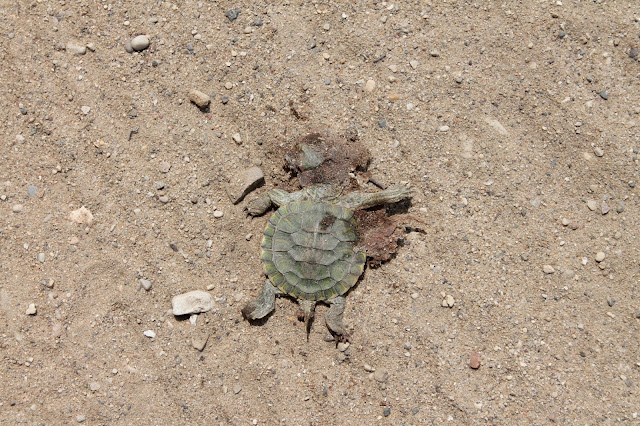It was a picturesque day. Advancing toward the preserve on the interstate, the air became cleaner and the horizon more and more perceptible. There's a lot of cropland between Chicago and this preserve. And even though cropland constitutes a rather dull landscape, there's something about the broad expanse of earth that appeals to me. It's almost comforting in a way I can't really adequately interpret. Sometimes I think that long drives out into rural areas are as therapeutic as they are because it's simply a long, largely uninterrupted foray out of a stressful element and into a world that I feel more part of. Along the way, I pass through tiny, economically-ravaged towns that have seen better days, and whose few holdout residents seem relegated to austere lifestyles. It's refreshing, in a completely non-condescending way, to see people living like this, even if they don't do it on their own volition. These are places where epiphanies are forged - reminders that not everyone in northern Illinois lives in an urban rat race, scurrying to get the cheese. Some do just fine with a few crumbs. And there's nothing wrong with that.
This preserve, located in teeny-tiny Putnam County, consists largely of reclaimed former cropland, which had historically been wetlands but later were drained to make room for corn. Following the removal of old drain tiles and the retirement of the pump house, the land slowly began taking on water, and is now once again a significant stop for migratory birds. Amphibians and turtles have returned by way of the Illinois River. Native fish such as pike and bowfin have been stocked. However, as lush as it seems to be, it's still a work in progress. One might observe a few old cut corn stalks sticking out of shallow sections of the wetlands, reminders that it wasn't all that long ago when this same place was nothing but a corn desert.
Aside from the expansive wetlands (which include two seeps), there are sandy areas and woodlands. These are the areas we focused on when we visited on May 21st. Our hopes once again were to supply the Wetlands Initiative with an updated (and ideally expanded) herpetofaunal list for their records. We saw some other really cool things along the way, of course.
A remnant sand savanna. This area is relatively steeply-sloped and very sandy, not an ideal place to plant corn. It borders the former corn field (now a series of wetlands once again) to the west and is topped by some older, large trees to the east. It is a stronghold for sand-loving plants and animals. Herps found here include bullsnakes, blue racers, racerunners, and eastern milk snakes.
A field of foxglove penstemon (Penstemon digitalis)
Our first herp of the trip was a bittersweet find - this blue racer (Coluber constrictor foxii) was a new species for the preserve, which was great. But unfortunately, like many others of its species, this one was afflicted with what I believe to be snake fungal disease (SFD), a condition that causes disfigurement of the face and head of the host, and in more severe cases, throughout the body. It seems like I've found more blue racers with SFD than without. The cause of SFD is not clear, though some speculate it could be a systematic reaction to glyphosphate, better known as Roundup.
One of many eastern garter snakes (Thamnophis sirtalis)
Maya with a chunky adult female garter snake.
A hatchling painted turtle (Chrysemys picta) makes its way to the water.
Some blue flag iris (Iris versicolor)
I often associate filth and slobbery with cities, but in fact human nature knows no boundaries. Here's a classic rural wooded dump site that yielded no herps.
One of the participants, Jeremy Schumacher, found these old Atari joysticks amid the giant heaps of human refuse.
The first of SEVEN milk snakes (Lampropeltis triangulum), and the only one found under natural cover. Credit goes to Colleen Schwarz for finding it.
Bee balm (genus Monarda)
We got permission from an adjacent landowner to search his property. We could tell it had potential because it was littered in stacks of old tin, piles of logs, mounds of tires. This old truck was tucked away behind some silos. It is slowly being consumed by the forest.
Matt Bordeaux and I made quick work of a smelly, decrepit old shed. So quick, he appears as a blur. There was nothing in here except for rat droppings and the sickening stink of motor oil and mildew.
This scene appears to be straight out of a Chris McCandless selfie. This old truck at some point somehow got to the top of a wooded hillside. Things that make you go hmmm...
A casualty of our environmental footprint, this hatchling red-eared slider (Trachemys scripta elegans) never even got to feel water. It was squashed like a penny on a rail right on a sandy access road about three hundred yards from the shoreline of the lake it was heading to. This was a new species for the preserve list.
One more gap filled for the preserve was the western fox snake (Pantherophus vulpinus), a species I'm surprised we didn't get last year. This large male was flipped under a board but placed in a tree by Matt for photos.
















No comments:
Post a Comment